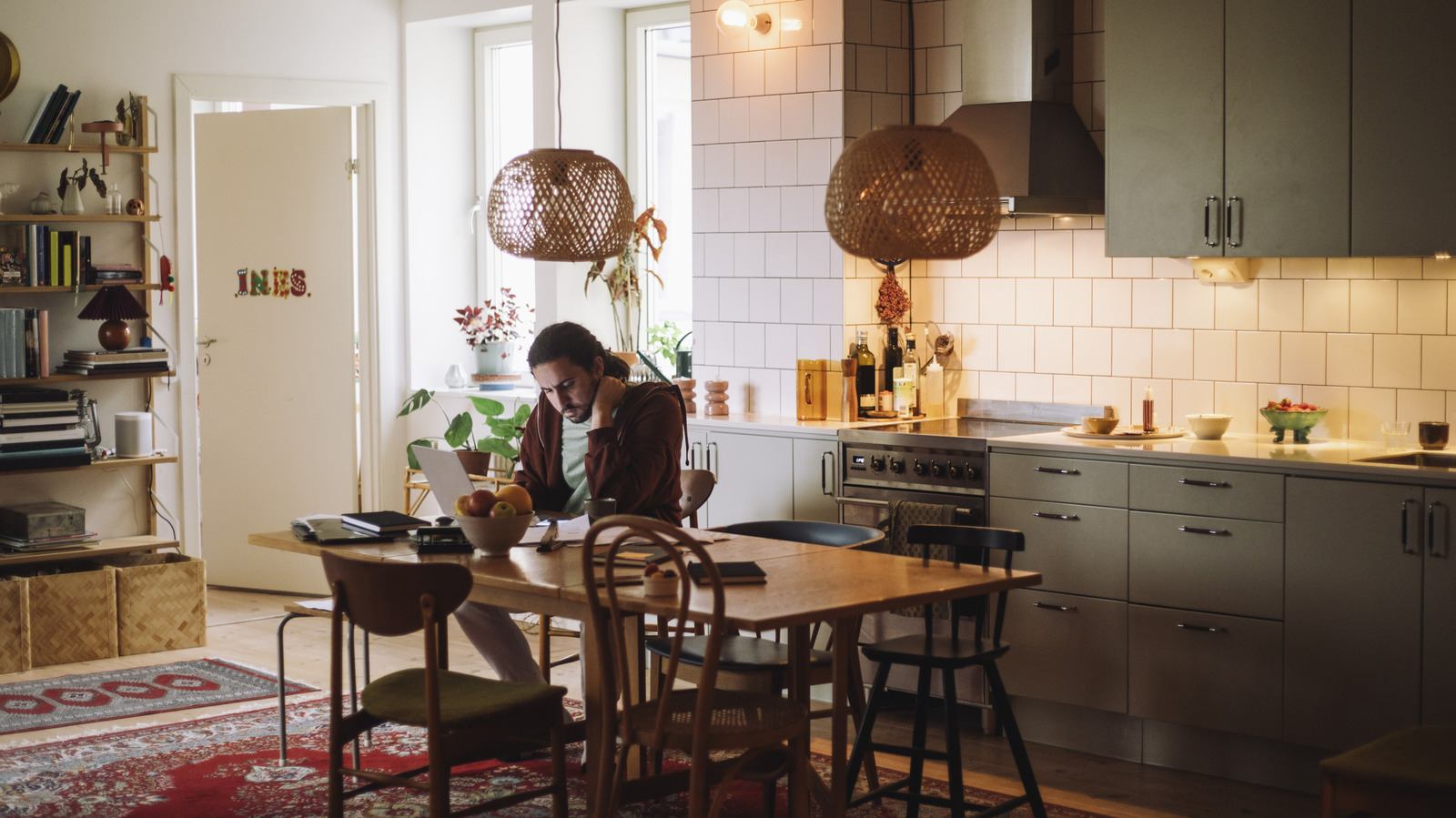We may receive a commission on purchases made from links.
Kitchen lighting is not a guessing game, or at least it shouldn’t be. There’s a whole science behind the best restaurant lighting, and it has to do with creating feelings of intimacy and comfort. “Lighting defines the kitchen’s emotional temperature,” says Rachel Blindauer, principal interior designer at Rachel Blindauer. “It’s the difference between sterile and soulful, practical and poetic. When we layer light intentionally, we’re not just making it easier to chop vegetables — we’re telling the space how to hold us.”
Along with being so important, the kitchen brings additional hurdles when it comes to light. “Lighting a kitchen presents unique challenges compared to other rooms in your home, as there’s a greater need for functionality,” says Marlena Kaminska, lead digital designer at ValueLights. “However, this doesn’t mean you have to compromise on style.” Indeed, there’s a balance between creative, beautiful lighting and cost. In fact, plenty of kitchen upgrades require no renovations whatsoever, and lighting is one of them.
The importance of kitchen lighting goes beyond beauty and functionality, though. “The kitchen has become the primary space in most homes,” says Alina Enache, co-founder of Lamp Genius. “Poor lighting makes the space feel unwelcoming and can actually make an expensive kitchen look dull or even cheap.” For example, dim lighting makes your kitchen feel extra-small, which is not so desirable. So how do you escape the bad lighting trap? Here are 17 creative ways to do so, thanks to advice from lighting experts.
1. Install smart dimming
“If I had to pick just one lighting feature that really makes a difference at home, I would choose a dimmer switch,” says Justin Cornforth, CEO of Ace Home Co. “A dimmer switch is just a tiny item added to the wall that allows you to adjust the vibe of your space, whether you’re cooking, relaxing, or hosting friends.” Sydney Sims, consumer advocate at Ownerly, agrees. “Experiment with dimmer switches to transition instantly from bright and useful to warm and intimate,” she says. The ELEGRP Digital Dimmer Light Switch is one option to achieve this.
Want to take things to the next level? Consider smart lighting, she says. With it, you can adjust both warmth and brightness levels to meet your specifications, and you can create presets for various times of day or activities. Plus, there’s the benefit of “having your kitchen adjust from morning frenetic to evening unwind at the touch or voice of a button.” It’s one of the best ways to make your space more usable instantly.
2. Use glass-blown pendants
Another of the best ways to jazz up your space quickly is a glass-blown pendant. “Hand-blown glass pendants are my go-to when clients want a statement piece that is something really unique and artistic,” Alina Enache says. “Each piece has its character and imperfections that make it special — you literally can’t get the same light twice.” You can spend a lot of money on pendant lights, but you don’t have to. Options such as a Casamotion Hand Blown Glass Ceiling Hanging Light are quite affordable.
As for where glass-blown pendant lights work, the answer is pretty much everywhere. “They work great as statement pieces over breakfast bars hanging centrally within the space,” Enache says. Especially when used in combination with adjustable ceiling spotlights or recessed downlights, Marlena Kaminska notes, they are very effective at creating layered light within a kitchen.
3. Designate prep areas
One of the best ways to minimize unnecessary hustle in the kitchen is to designate prep areas. You likely already know where these are: the counter or island toward which you gravitate when it’s time to chop, the side of the stove you use as a staging area, or the corner where you place prepped dishes ready to go on the table. One of the best and most creative ways to make your kitchen workflow easier is to use lighting to highlight these areas.
“A well-lit kitchen is not only about good looks; it allows you to work safely and with ease, particularly in critical prep areas,” Sydney Sims says. “As an added amenity, excellent lighting can help set the overall style and tone of the room, making it look inviting and lovely done.” Use pendants or can lights to ensure good illumination over these prep surfaces, which not only makes your life easier, but indicates to others where they should work.
4. Employ task lighting
“Ever cut your finger with a knife because your cutting board was cast in a shadow? Have difficulty seeing what the worn numbers are on your pesky measuring spoons?” asks Tyler Markham, content manager at Regina Andrew Detroit. “That’s why lighting is so important in your kitchen. It needs to be functional.”
He recommends breaking down the lighting in your kitchen into three categories: ambient, accent, and task. “Task lighting is by far my favorite,” he says. “It can come in many forms, but essentially, it’s a sconce or lamp you’re able to adjust and move to a specific area you want to illuminate. Perfect for preparing dinners.” If you don’t want your task lighting to be movable, that’s fine; you can achieve the same effects with track lights or directional spots, says Sydney Sims.
Whatever the case, just keep in mind that one of the most common kitchen lighting mistakes is using a single light source, putting it directly overhead, and casting deep shadows. The best response to this? Task lighting.
5. Create atmosphere with ambient lighting
Next arm of the task-ambient-accent trifecta: ambient lighting. “Lighting has a setting function in a kitchen — not only visually, but emotionally and practically,” Sydney Sims says. “It assists in creating the atmosphere, whether chopping veggies or entertaining friends over wine and dialogue.” The goal of ambient lighting is to bring a soft, widespread glow that unifies the room, Sims explains. To accomplish this, she recommends starting with recessed or flush-mount fixtures that will create an overall, polished level of light. Once you’ve laid the groundwork, supplement with area lights: pendant, task, or spotlighting on specific areas.
“Most people don’t think about it, but the color temperature of your bulbs can make a big difference in how your kitchen feels,” Justin Cornforth adds. He recommends using cooler white light for task areas such as countertops, stoves, and sinks. A range of 4,000 to 5,000 K, where K stands for Kelvin, is best. Where you want a cozier vibe, like over a breakfast bar, go for warmer temps, ranging from 2,700 to 3,000 K.
6. Accentuate your art
Last of the three types of light — task, ambient, and accent — comes accent. There are many creative ways to put this to work to bring your kitchen to life. For instance, says Rachel Blindauer, you can nestle an uplight in a planter beneath an indoor tree or place it inside cabinetry to highlight dramatic china or vases. “This type of lighting creates soft shadows that make materials glow,” she says. “It’s ambient, atmospheric, and incredibly grounding — especially at night.”
Flexible LED cans are one of her favorite approaches to accentuation, because they’re so flexible. “They let you spotlight focal points — to honor the stove, kitchen, sink, and any art that is significant.” You can also use accent lighting to bring attention to beautiful backsplashes or murals, bold paint colors, or textured wallpaper, Sydney Sims says.
7. Light up your cabinets
Under-cabinet lighting might seem kind of boring, but it’s one of the best strategies to employ if you want your kitchen fully illuminated. “Under-cabinet lighting doesn’t just light your work surfaces; it projects ambient light out into kitchen walkways and floors around the cabinets, which gives you this lovely warm atmosphere,” Alina Enache says. “I always tell clients this is a must-have because you’ll be using it constantly, even more than central light fittings.” That’s true, she says, whether you’re prepping food, cleaning up, or just moving around the kitchen in the evening. Plus, Rachel Blindauer adds, “It also helps highlight materials: wood grain, glassware, hand-thrown pottery. It makes function feel like form.”
Ideally, you want to hide the lights under the cabinets with some smart engineering. Enache recommends recessing the LED strips into the cabinets. Just a little creativity will hide their profile and produce a soft glow that seems to come from nowhere. If you’re remodeling your kitchen, it’s a good idea to plan this in from the get-go. “If you’re sourcing the components yourself,” she adds, “Check that you have enough cable length from the strip to wherever you’re tucking away the driver box.”
8. Cluster your lighting
One of the best ways to take regular lighting to the next level is to group it in unexpected ways. “Whether it’s a grouping of mismatched globes or a single large shade, pendants provide boundless opportunity for creativity and visual punch,” Sydney Sims says. Alina Enache agrees, often using clusters of pendant lights over kitchen islands, where they provide practical illumination for work tasks. “You can play with different heights and spacing to create different looks,” she says. “Whether it’s three identical pendants or a mix of different colors, they draw the eye and define the island as the focal point of the kitchen.”
Another way to increase the appearance of lighting is to magnify it using non-light sources. Mirrors make dark kitchens appear lighter, so hanging them strategically, in such a way as to bounce more light around the room, is one of the best ways to brighten things up. You’ll simultaneously draw attention to that artful cluster in more than one part of the room. Reflective tile and light surfaces can perform the same service.
9. Play with warm and cool
As discussed, lighting comes in different temperature ranges. The color of your bulbs can change your kitchen’s visual impact with just a subtle shift into the warmer or cooler side of the range, instantly transforming the mood of the kitchen. “Warm lights feel like they’re beckoning and cozy, while cool tones are more visibility- and attention-friendly,” Sydney Sims explains.
While the best approach is to avoid clashing warm and cool tones, you can still use both in your kitchen. Just make sure they’re all generally warm or generally cool, so they don’t fight and create weird zones. You can also play with warm and cool in your finishes and textures. Blending warm wood tones, metallics, and mixed textures keeps the appearance lively and bespoke, Sims says.
10. Put in art deco chandeliers
Art Deco chandeliers are perhaps the best way to bring wow factor to a room. “The mix of metals, geometric forms, and glass just screams luxury to me,” Tyler Markham says. “These pieces may be hard to fit in a more modern space, but think of placing one above your kitchen island and tell me people don’t comment on it every time they see it!”
Justin Cornforth agrees that if you love geometric shapes and vintage glam, it could be a match made in heaven. “But keep in mind, you’ll need high ceilings to make them work, or they’ll overwhelm the space,” he says and adds, “They light up a space pretty well, especially when hung above the dining table, but are not enough for serious task lighting.” You will definitely need additional lights.
If you’re more a fan of Art Nouveau than Art Deco, you can switch out the bold geometric designs for more flowing organic shapes. Tiffany lamps can provide a lovely vintage twist to your kitchen, while simultaneously lighting up a dim corner and making it more usable. And if you think using standing lamps in your kitchen is weird, Ina Garten totally uses this kitchen lighting hack.
11. Hang colored pendants
“Big, bright colors are so in,” Tyler Markham says. “If you are having trouble adding color to your kitchen, the perfect way to do so is with a colored pendant. Think rich navy dome lights, milk-glass globe lights with a green base, or gold-leafed interior. Anything to draw the eye.” You can walk into a lighting store and find all kinds of fun options, but you can also find them online for affordable prices. Pieces such as the Edishine Hand Blown Blue Glass Pendant Lighting, Art Glass Mini Blown Art Glass Pendant Light, or 3-Pack Mini Blue Marble Glass Pendant Lights are all fun additions to a cooking space.
Just like art deco lamps, though, they’re not that bright. The best fix? “You’ll need a few of them in a row to get good light coverage over a kitchen island or a long table,” Justin Cornforth says. This is another good opportunity for mix-and-match fun. “Just make sure all light bulbs are of the same color temperature to avoid an uneven weird look.”
12. Decorate with sculptural lights
Sculptures that double as lights? Yes, please. “If you want to create a focal point in your kitchen or add a bit of whimsy to your space, sculptural fixtures are the perfect way to add ambient light,” Tyler Markham says. “Think of the surroundings when choosing these fixtures. Is my kitchen longer, or more square? A longer kitchen or island will look better with a linear chandelier pendant or multiple sculptural pieces.”
You shouldn’t expect much beyond stunning looks from your sculpted lights, though, says Justin Cornforth. “Sculpted lights don’t put out a ton of light, they’re more about creating mood and ambiance,” he says and adds, “so they’re better in kitchens where you already have enough functional lighting.” Above an island, breakfast nook, or prep zone are all good options, Rachel Blindauer adds.
13. Match your switch covers
One of the best ways to make your kitchen decor cohesive is to match your switch covers to the other fixtures in the room. “If you have metal finishes in your kitchen, match them with brushed brass or chrome sockets to pull the whole look together,” Marlena Kaminska says. “Sockets and switches offer functionality, but that doesn’t mean they can’t seamlessly match your interior design.” Try an Enerlites Toggle Light Switch Metal Wall Plate or Enerlites Toggle Light Switch Stainless Steel Double Wall Plate to get this look.
This helps bring dynamic layering and texture to your overall lighting design, Sydney Sims notes. “Lighting isn’t merely the ‘glam’ stuff,” she says. “It needs to be part of your design strategy from the get-go. The appropriate fixture in the appropriate place is everything.” Take the time to make sure fixtures, finishes, switch plates, and lights all play nicely, and you will love the overall effect.
14. Employ industrial-style lighting
Industrial lighting is best for those who want a down-to-earth, utilitarian feel in their kitchen, Sydney Sims says. They look basic but beautiful, and attractive without sacrificing functionality. “It works with exposed beams, natural wood, or metal finishes, and makes a bold design statement without being too much.” Something like the SunRider Industrial 4-Light Semi Flush Mount Ceiling Light Fixture would be a good place to start.
Whatever your personal style, you can expect industrial lights to bring authenticity and character to your space. “I love using exposed Edison bulbs in metal cages or warehouse-style pendant lights,” Alina Enache says. “They add that raw feel to the interior.” Tinted filament light bulbs work well here, she adds.
15. Install wall sconces
Another great way to highlight a specific spot, like a pretty sink area with lots of plants or a key piece of art that means a lot to you is to use sconces. “Lighting is not only a way to illuminate but frame a space,” Tyler Markham sums up. Place your sconces on either side of the spot you want to illuminate, and the two bookends will naturally draw the eye where you want it to go.
Sconces are super flexible as well. “Wall sconces can be anything,” Markham says, “from task sconces that you’re able to move to ambient pieces that add a glow to your kitchen island. But the most important part is layering the light so that it hits every usable space in your kitchen.” Make sure to hang your sconces where they’ll add the most illumination, whether you choose this Set of 2 Wall Sconces that require wiring or opt for simple Niorsun Battery Operated Wall Sconces.
16. Hang linear chandeliers
Linear chandeliers lend a lovely industrial look to your kitchen that you can’t get with any other statement piece. Moreover, they help light up odd spaces while making it look like your lighting choices are totally intentional. “Linear chandeliers are perfect for longer islands or dining areas because they provide even light distribution across the entire surface,” Alina Enache says. “I prefer ones with steel shades for a more industrial, modern look or glass shades when you want something softer.” If you want to take a low-road approach, the Amzasa Black Rectangular Modern Industrial Chandelier and Electro 4-Light Linear Matt Black Chandelier are both worth considering.
It’s true that kitchen chandeliers are unconventional, Sydney Sims acknowledges, but she likes the surprising elegance they offer. “It is particularly effective in open kitchen-dining areas, serving as a show-stopping centerpiece that unifies the room.”
17. Pop a lamp in the corner
What could be cozier than simply putting a lamp in the corner of your kitchen? “Even something as simple as placing a small lamp on a corner counter can add warmth and character to an otherwise forgotten area,” Sydney Sims says. You can turn that area from underlooked to cheerful and utilitarian in one fell swoop, the best of both worlds.
If you cook a lot, just make sure to avoid fabric shades in the kitchen. “All that grease, steam, and smoke will quickly turn the fabric color and make them look dirty,” Alina Enache says. “Even if you try cleaning them, the shades never look the same as when you first put them up.” For this reason, she always recommends glass, metal, or other hard surfaces; anything you can wipe down is fine. A Lightshare 18-Inch Cherry Blossom Bonsai Tree or Tiffany Style Sunflower Table Lamp would both be cute.




